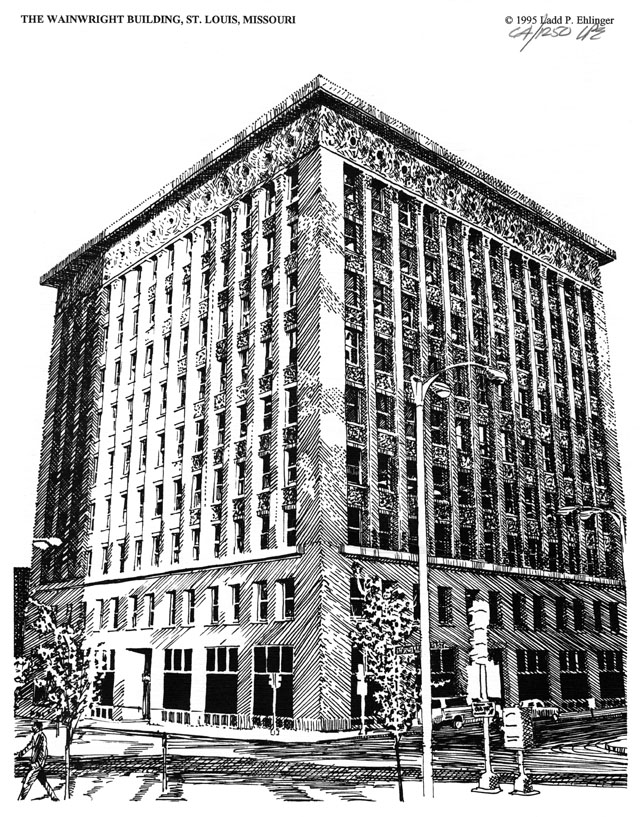
Projects Newsletters Personnel Contact

Frank Lloyd Wright related the moment of the creation of the American skyscraper: "As [Sullivan] threw the 'stretch ', with the first three bays outlined in pencil upon it, I sensed what had happened. In his vision, here beyond doubt, was the dawn of a new day in skyscraper architecture. " Wright also saw or came to see that the "picturesque verticality....although appropriate, was still a mere facade....prophetic, if not profound " Even with this clear an analysis, Wright never lost respect for that moment of creation, or of "lieber Meister", his nickname for Louis Henri Sullivan, his mentor and teacher.
Sullivan was the architect for the Wainwright Building in St. Louis, Missouri (1890-91), the subject of this issue’s limited edition signed print by Ladd P. Ehlinger. Sullivan coined the famous dictum (some say cliche): "Form follows function", which schooled several generations of architects. This dictum spawned the functionalist school of modern architecture, which strived to derive forms for buildings that expressed the functions they contained.
He also wrote profusely, of architectural philosophy and theory, much of it enigmatic and nervously incomprehensible. But his writings did enshrine him as a legend and publicize his achievements, which were considerable. Sullivan's most understandable essay "The Tall Building Artistically Considered" was published in 1896, after the completion of the Wainwright Building.
Even so, the opening premise of the essay is that the "very essence of every problem [is] that it contains and suggests its own solution. " The program for the tall office building as Sullivan saw it was: " Wanted-1st a story below ground, containing boilers, engines of various sorts, etc.- in short the plant for power, heating, lighting, etc. 2nd, a ground floor, so called, devoted to stores, banks, or other establishments requiring large area, ample spacing, ample light, and great freedom of access. 3rd, a second story readily accessible by stairways-this space usually in large subdivisions, with corresponding liberality in structural spacing and expanse of glass and breadth of external openings. 4th, above this an indefinite number of stories of oflices piled tier upon tier, one tier just like another tier, one office just like all the other offices-an office being similar to a cell in a honeycomb, merely a compartment, nothing more. 5th, and last, at the top of this pile is placed a space or story that, as related to the life and usefulness of the structure, is purely physiological in its nature-namely the attic.
In this the circulatory system completes itself and makes its grand turn, ascending and descending. The space is filled with tanks, pipes, valves, sheaves, and mechanical etcetera that supplement and complement the force originating plant hidden below ground in the cellar. Finally, or at the beginning rather, there must be on the ground floor a main aperture or entrance common to all the occupants or patrons of the building. "
The facades of the Wainwright Building are certainly in accord with Sullivan's program. However, many critics have blasted the blockiness of the building, the irrational structural expression of the large columns equal in size between every window of the offices (a real, structural column exists every two windows), and the excessively large cornice at the top that is not expressive of the structure. The wide elevations or facades of the building do not express the fact that it is "U" shaped in plan, to form a light court and provide for ventilation. In any event, the Wainwright is generally recognized as the first tall building ever to aesthetically express its tallness in a non-eclectic manner.
Today the Wainwright has been restored in part and adapted in use as a bureaucratic office building by the State of Missouri and added on to with a low wing to the right of the view shown. The light court has been enclosed to form an atrium, rather clumsily. The building has been saved though, and is a national treasure worth seeing if you are in St. Louis.